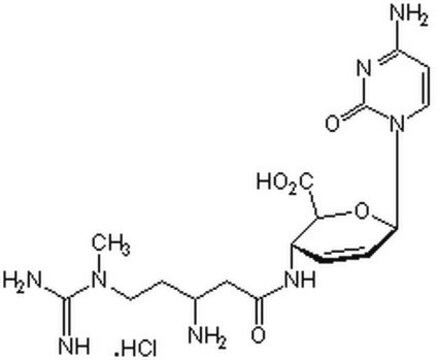Key Documents
H3274
Hygromycin B from Streptomyces hygroscopicus
powder, non-animal origin, suitable for cell culture and insect cell culture, BioReagent
Synonim(y):
Hygromycin
About This Item
Polecane produkty
product name
Hygromycin B from Streptomyces hygroscopicus, powder, BioReagent, suitable for cell culture, suitable for insect cell culture
pochodzenie biologiczne
Streptomyces hygroscopicus
Poziom jakości
linia produktu
BioReagent
Postać
powder
stężenie
≥60% (HPLC)
metody
cell culture | insect: suitable
cell culture | mammalian: suitable
kolor
faintly brown to brown
white to beige
(1) 7.1, (2) 8.8
mp
160-180 °C
rozpuszczalność
H2O: 50 mg/mL (As a stock solution. Stock solutions should be stored at 2-8°C. Stable at 37°C for 30 days.)
spektrum działania antybiotyku
fungi
Tryb działania
protein synthesis | interferes
temp. przechowywania
2-8°C
ciąg SMILES
CN[C@H]1C[C@@H](N)[C@H](O)[C@@H](O[C@@H]2O[C@H](CO)[C@H](O)[C@@H]3O[C@]4(O[C@H]([C@H](N)CO)[C@H](O)[C@H](O)[C@H]4O)O[C@H]23)[C@@H]1O
InChI
1S/C20H37N3O13/c1-23-7-2-5(21)9(26)15(10(7)27)33-19-17-16(11(28)8(4-25)32-19)35-20(36-17)18(31)13(30)12(29)14(34-20)6(22)3-24/h5-19,23-31H,2-4,21-22H2,1H3/t5-,6-,7+,8-,9+,10-,11+,12-,13+,14-,15-,16+,17+,18-,19+,20+/m1/s1
Klucz InChI
GRRNUXAQVGOGFE-XKIAHZFYSA-N
Szukasz podobnych produktów? Odwiedź Przewodnik dotyczący porównywania produktów
Powiązane kategorie
Opis ogólny
Zastosowanie
- transfected 293T cells with mixture of plasmids at 160 μg/ml.
- MCF-7ALOX12 cells at 150 μg/ml.
- MSCV Luciferase PGK-hygro plasmid.
- STAT3 Reporter HeLa Stable Cell Line (stably transfected with Luciferase gene under the control of STAT3 promoter) maintained in DMEM supplemented with 10% FBS.
Działania biochem./fizjol.
Antimicrobial Spectrum: Hygromycin B acts against bacteria, fungi and higher eukaryotic cells.
Przestroga
Uwaga dotycząca przygotowania
Hasło ostrzegawcze
Danger
Zwroty wskazujące rodzaj zagrożenia
Zwroty wskazujące środki ostrożności
Klasyfikacja zagrożeń
Acute Tox. 1 Inhalation - Acute Tox. 2 Dermal - Acute Tox. 2 Oral
Kod klasy składowania
6.1A - Combustible acute toxic Cat. 1 and 2 / very toxic hazardous materials
Klasa zagrożenia wodnego (WGK)
WGK 3
Temperatura zapłonu (°F)
Not applicable
Temperatura zapłonu (°C)
Not applicable
Certyfikaty analizy (CoA)
Poszukaj Certyfikaty analizy (CoA), wpisując numer partii/serii produktów. Numery serii i partii można znaleźć na etykiecie produktu po słowach „seria” lub „partia”.
Masz już ten produkt?
Dokumenty związane z niedawno zakupionymi produktami zostały zamieszczone w Bibliotece dokumentów.
Klienci oglądali również te produkty
Produkty
Protein synthesis is a complex, multi-step process involving many enzymes as well as conformational alignment. However, the majority of antibiotics that block bacterial protein synthesis interfere with the processes at the 30S subunit or 50S subunit of the 70S bacterial ribosome.
Antibiotic kill curve is a dose response experiment in which mammalian cells are subjected to increasing amounts of selection antibiotic
Krzywa zabijania antybiotyków to eksperyment dawka-odpowiedź, w którym komórki ssaków są poddawane rosnącej ilości antybiotyku selekcyjnego.
Protokoły
Extraction and quantitative analysis of aminoglycosides in porcine tissue, using molecular imprinted polymer solid phase extraction followed by LC-MS/MS.
Stem Cell protocols for cryopreservation, thawing of cryopreserved stem cells and media preparation.
Nasz zespół naukowców ma doświadczenie we wszystkich obszarach badań, w tym w naukach przyrodniczych, materiałoznawstwie, syntezie chemicznej, chromatografii, analityce i wielu innych dziedzinach.
Skontaktuj się z zespołem ds. pomocy technicznej









